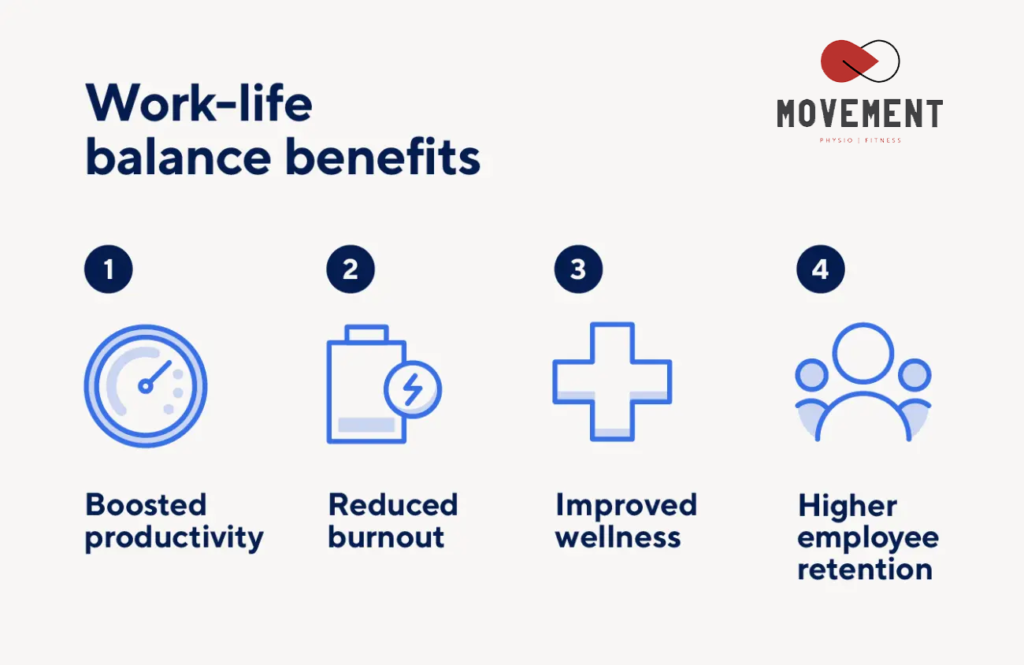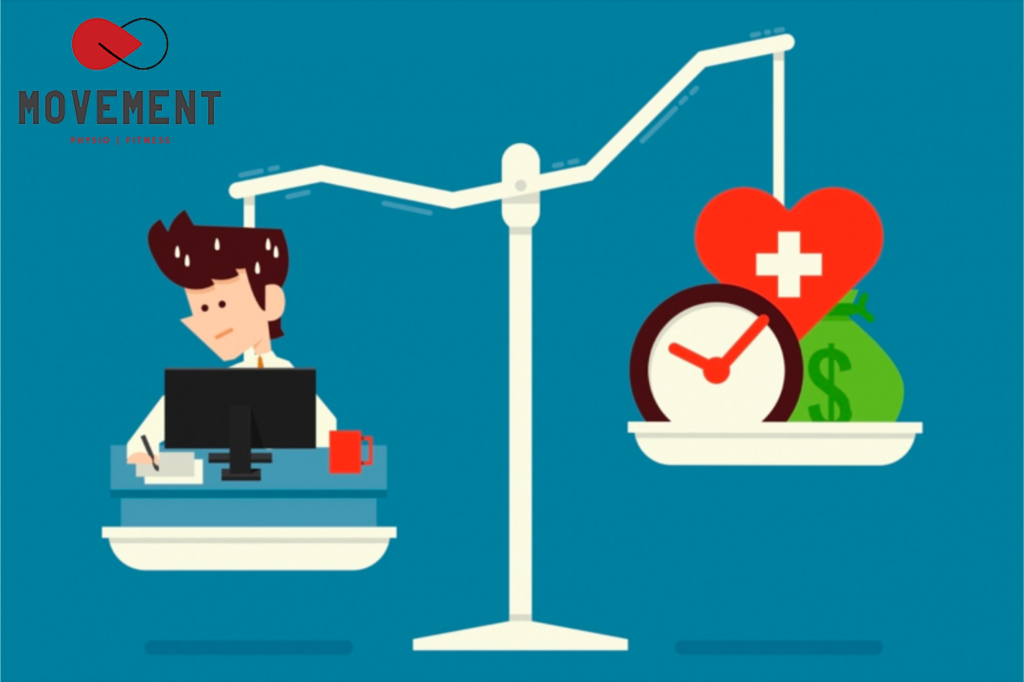Drowning in work? You’re in good company. The line between the office and living room blurs.
Efficiency at work, peace at home – how?
Beyond working out, what’s the secret?
In a world where work follows you home, finding balance feels like a myth. Yet, it’s within reach.
Here are some inspiring examples of individuals who have found a balance between work and life:
- Arianna Huffington
Arianna Huffington, the founder of The Huffington Post, is a well-known advocate for work-life balance. She believes that success should not come at the cost of one’s well-being and personal life. In her book, “Thrive: The Third Metric to Redefining Success and Creating a Life of Well-Being, Wisdom, and Wonder,” she shares her personal journey of finding balance and encourages others to do the same.
Huffington practices what she preaches by setting boundaries for herself, such as not checking her phone before bed and taking time for meditation and exercise. She also encourages her employees to prioritise their well-being and offers nap rooms and meditation classes at The Huffington Post office.
- Richard Branson
Richard Branson, the founder of Virgin Group, is known for his successful business ventures, but he also prioritises his personal life. He believes that a healthy work-life balance is crucial for success and encourages his employees to do the same.
Branson is known for his adventurous lifestyle, and he often takes breaks from work to spend time with his family and pursue his hobbies, such as kiteboarding and hot-air ballooning. He also encourages his employees to take time off and offers unlimited vacation time to his staff.
- Sheryl Sandberg
Sheryl Sandberg, the COO of Facebook, is a working mother who has found a balance between her career and personal life. In her book, “Lean In: Women, Work, and the Will to Lead,” she shares her experiences and encourages women to pursue their career goals while also prioritising their personal lives.
Sandberg is known for leaving work at 5:30 pm to have dinner with her family and for taking time off to attend her children’s school events. She also encourages her employees to prioritise their personal lives and offers flexible work arrangements to support this.
Let’s dive into the habits that tip the scales. Discover strategies for workers and bosses alike to master the juggle of job and joy.
What’s the secret to true work-life balance?

Finding the sweet spot between career and personal joy means crafting a life where work and play not only coexist but flourish together. It’s about dividing your energy wisely – so your job fuels you and your personal life rejuvenates you.
Imagine clocking out and diving into activities that recharge your soul. Whether it’s laughter with loved ones or losing yourself in a hobby, it’s all within reach.
Key ingredients for a balanced life
Draw the line: Set firm boundaries. Work stays at work. Home is your sanctuary.
Master your time: Prioritize and organise. Work efficiently, and unwind wholeheartedly.
Tame your stress: Find your calm. Exercise, meditate, and disconnect to reconnect.
Embrace flexibility: Life’s curveballs are inevitable. Adapt your schedule without sacrificing your sanity.
Why work-life balance is non-negotiable:
Variety isn’t just the spice of life; it’s its backbone. A monochrome routine of all work and no play dulls your sparkle. We’re not machines—constant productivity is a myth that leads to burnout, not brilliance.
Moreover, the cost of ignoring life outside the office is too high. Overwork spells trouble for both the individual and the organisation. Burnout, stress, and fatigue are more than personal issues; they’re productivity killers.
In pursuit of balance, we find not only happiness but also efficiency. It’s time to break the cycle of endless work and rediscover the joy of living.
Balancing work and life: Avoiding the pitfalls
An unhealthy work-life balance isn’t just a minor inconvenience; it’s a critical issue that can derail your overall well-being. This imbalance often manifests when work consumes the bulk of your time and energy, pushing your personal life to the sidelines. Here’s a closer look at the fallout of letting work tip the scales:
Endless overworking: Picture this, your workdays bleed into nights, and weekends are just another opportunity to catch up on emails and holidays. They’re spent with a laptop as your companion. The concept of “enough” work becomes elusive as downtime fades into a mythical notion.
Personal life on pause: Your hobbies gather dust, relationships simmer on the back burner, and “me time” is a forgotten luxury. Life outside the office shrinks, leaving you feeling like a spectator in your own story.
The burnout boogeyman: Physical, emotional, and mental exhaustion becomes your new baseline. Stress from unrelenting work pressures cooks up a perfect storm of burnout, leaving you feeling drained and detached.
Self-care strikes out: Regular exercise, sufficient sleep, and leisurely pauses are sacrificed on the altar of productivity. Your health—both mental and physical—pays the price for this neglect.
Relationships on the rocks: Work stress doesn’t stay neatly compartmentalised; it spills over, causing friction and distance in your relationships with family and friends. Your support network feels the strain as work monopolises your time and energy.
The broader impact of work-life imbalance
The consequences of a lopsided work-life dynamic stretch far beyond personal dissatisfaction. Research underscores the grave implications: workers logging over 55 hours a week face a heightened risk of stroke, along with spikes in anxiety and depression rates. Contrary to the badge of honor often associated with long hours, this grind can erode your physical health, even with adequate sleep. The symptoms of imbalance are varied but unmistakably detrimental:
Work obsession: Unable to unplug, your mind is perennially stuck in work mode, blurring the line between office and home life.
Frayed connections: As work takes precedence, irritability takes root, and your once-warm relationships grow cold and distant.
Physical and mental decline: Unexplained aches, a perpetual energy deficit, and a foggy focus become your daily companions.
Apathy towards Life: Activities that once sparked joy now feel mundane, leading to social withdrawal and a loss of interest in anything beyond work.
Neglected personal responsibilities: Everyday tasks and chores pile up, symbolizing the deferred maintenance of your personal life.
Vacation as a foreign concept: Sick days go unused, and the thought of taking a vacation feels like a fantasy.
Career crisis: Doubts about your job’s sustainability creep in, challenging your once-passionate commitment to your career.
Existential unease: A pervasive sense of being perpetually out of place gnaws at you, hinting at a deeper crisis of purpose and presence.

Crafting a path of harmonious balance
Achieving a harmonious work-life balance isn’t about finding a one-size-fits-all solution; it’s a personal journey that requires introspection, experimentation, and adjustment. Here are strategies to consider:
Strategic planning: Integrate work with elements of leisure, social interaction, or physical activity. Transform back-to-back virtual meetings with walks or outdoor calls, blending productivity with physical well-being.
Brain-compatible working: Leverage productivity hacks like the Pomodoro Technique to harness short, intense focus sessions, minimising distractions and maximising output. Here’s how the technique works, you set the timer for 25 minutes and focus on just one task, nothing else. No checking emails, no social media, just work. When the timer goes “ding!”, you take a short break, about 5 minutes, to relax and recharge. Stretch, grab a cup of tea, or just daydream. After four of these cycles, you take a longer break, around 15 to 30 minutes to really unwind.
The beauty of this technique? It keeps your brain fresh and motivated. Plus, it turns work into a series of manageable chunks, making even the biggest tasks less daunting. Give it a try with any timer, and watch your productivity soar!
Task time-blocking: Allocate specific blocks of time for distinct tasks—checking emails, taking meetings, and tackling high-concentration work—to sync with your natural productivity rhythms.
Defined workday closure: Establish a concrete end to your workday. Reinforce this boundary by shutting down work devices and physically demarcating your work from your living space.
Tech tools for disconnection: Employ apps to block distracting sites during work hours and silence work notifications post-work. If possible, dedicate specific devices to work to strengthen the mental division between work and leisure.
Revitalise lunch breaks: Whether working from home or in an office, take your lunch break as a sacred pause. Dine out, connect with colleagues, or simply step away from your desk to refresh and refuel.
Prioritise time off: Recognize the importance of taking sick leave, vacation days, and personal time. These breaks are crucial for mental and physical recovery, as well as maintaining a broader perspective on life beyond work.
Embrace mindfulness: Mindfulness practices can sharpen your awareness of when work starts to encroach on your personal needs. Techniques like meditation and focused breathing can help recalibrate your priorities, making it harder to ignore the signs of imbalance.
Cultivate passions outside work: Engaging in hobbies or activities that excite you can provide a compelling reason to disconnect from work, infusing your off-hours with energy and creativity.
Reevaluate your work’s alignment: If your job feels misaligned with your interests or values, consider ways to shift your role or responsibilities to reignite your passion and sense of purpose.
Open communication: Discuss your work-life balance challenges with your manager. Together, you can identify priorities and adjust workloads or deadlines as necessary.
Professional guidance: For those feeling overwhelmed, consulting a coach or therapist can offer a fresh perspective, helping you to pinpoint effective changes and strategies for implementing them.
Remember, realigning your work-life balance is a gradual process. Start with manageable adjustments and build from there, knowing that each small step is part of a larger journey towards a more balanced and fulfilling life.

Remote work: The double-edged sword of work-life balance
At first glance, remote work seems like the golden ticket to work-life equilibrium. No commute, no dress code, and your kitchen is your cafeteria. Yet, this modern convenience comes with its own set of hurdles. Multitasking, endless distractions, and the blur between “office” hours and home time can wreak havoc on productivity and personal peace.
Before the world knew of COVID-19, only a fifth of the U.S. workforce experienced these challenges from their living rooms. Then, seemingly overnight, that figure catapulted to 70%. Our homes morphed into multi-functional hubs—offices, schools, restaurants, gyms, and theaters—all rolled into one.
Sure, the perks are undeniable. Goodbye, traffic jams; hello, home-cooked meals and mid-day laundry. But here’s the catch: When your home doubles as your office, the lines between work and play don’t just blur; they vanish. Without the physical act of leaving an office, how does one signal the brain that it’s “closing time”?
Your bedroom corner or kitchen table, now commandeered as your workstation, keeps you tethered to your job long after you’ve logged off. The temptation to “quickly check an email” becomes a round-the-clock possibility. And while we save time by skipping the commute, many of us miss that precious transition period—a moment to switch gears from professional to personal mode.
In these socially distant times, the quest for balance has become even trickier. With many leisure activities on indefinite hold, the gravitational pull towards work intensifies. The casual chat with the marketing team suddenly becomes a stand-in for the socializing we’re missing from gyms, concerts, and dinners out.
Did you know?
According to a startling 2023 Gallup report, a whopping 77% of employees find themselves drifting through their workdays, disconnected and disengaged. This isn’t just a small hiccup in the corporate machine—it’s a significant issue that costs companies dearly and piles on unnecessary stress for employees.
But here’s where it gets fascinating: The report sheds light on a powerful insight that could revolutionise how we think about our work lives. Engagement at work isn’t just a nice-to-have; it’s a crucial factor that holds 3.8 times more sway over employee stress levels than whether they’re tapping away at their keyboards in a remote setting or sitting in an office. That’s right—feeling connected and involved in your work has a profound impact on your stress levels, far outweighing the debate between remote and office-based jobs.
So, what’s the takeaway from this eye-opening revelation? It’s a call to action for each of us to dive deeper into our work engagements to seek out those connections and opportunities that light a spark within us. By fostering a work environment and culture that values and promotes engagement, we’re not just enhancing our productivity; we’re actively carving out a path to a more balanced, fulfilling work-life experience.
Let this be the nudge you need to explore how you can become more engaged in your work. It’s not just about ticking off tasks on your to-do list; it’s about finding meaning, satisfaction, and joy in what you do. The benefits are clear: less stress, a healthier work-life balance, and a more vibrant, energised approach to each day. In the quest for a fulfilling career, engagement isn’t just the key—it’s the whole lock.
Crafting your work-home harmony
Acknowledging the skew in your work-home scale is the crucial first step. Correcting this imbalance isn’t an overnight fix but a series of deliberate choices and habits. Here’s where the magic of small, daily, or weekly rituals comes into play, gradually steering you towards a more balanced existence.
If plotting the course back to equilibrium feels daunting, consider enlisting a coach. Tailored guidance can illuminate the path forward, helping you weave work-life harmony into the fabric of your everyday. With the right strategies, the dream of a balanced remote work life is not just possible; it’s within reach.

Add your first comment to this post